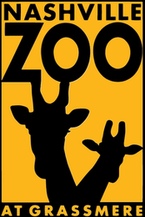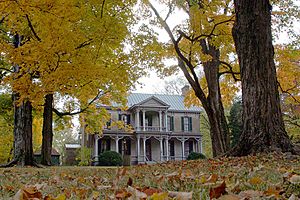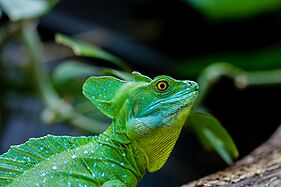Nashville Zoo at Grassmere facts for kids
 |
|
| Date opened | 1990, as Grassmere Wildlife Park |
|---|---|
| Location | 3777 Nolensville Pike, Nashville, Tennessee, United States |
| Land area | 188 acres (76 ha) |
| Coordinates | 36°05′21″N 86°44′37″W / 36.08917°N 86.74361°W |
| No. of animals | 6,230 |
| No. of species | 339 |
| Annual visitors | 1.2 million |
| Memberships | Association of Zoos and Aquariums |
The Nashville Zoo at Grassmere is a super cool zoological garden and a historic family farm. You can find it about 6 miles southeast of Downtown Nashville. It's one of the most popular places to visit in middle Tennessee. The zoo is home to over 6,230 individual animals. These animals represent 339 different kinds of species! The zoo covers a huge area of about 188 acres. It is also a special member of the Association of Zoos and Aquariums. This means it follows high standards for animal care. Around 1.2 million people visit the Nashville Zoo every year.
Contents
How the Zoo Started
The Old Farm History
The land where the Nashville Zoo is today was once a large farm. It was owned by Michael and Elizabeth Dunn. Their old home, built in 1810, is still on the property. The last family members to live there were Margaret and Elise Croft. They were the great-great-granddaughters of Michael Dunn.
In 1989, experts found an old cemetery near the farm's entrance. It was a burial ground for African-Americans who lived and worked on the farm long ago. When the zoo started building in 1997, this cemetery was not disturbed. Later, in 2013, the zoo planned a new entrance. The remains from the cemetery were carefully moved closer to the historic Dunn house.
Grassmere Wildlife Park Opens
The Croft sisters gave the land and family home to the Children's Museum of Nashville in 1964. They wanted the house to stay. They also wanted the land to be a "nature study center." After Elise Croft passed away in 1985, the museum started this nature center. They called it Grassmere Wildlife Park.
The Nashville Zoo Moves In
Grassmere Wildlife Park closed its doors in December 1994. The city of Nashville then took over the property in 1995. They looked for a group to manage the land. At the same time, the Nashville Zoo had opened in Joelton, Tennessee, in May 1991. It was a separate, private zoo.
In June 1996, the mayor of Nashville, Phil Bredesen, suggested a big idea. He thought the Nashville Zoo should move from Joelton to the Grassmere site. Or, Grassmere could become a city park without animals. In October 1996, the Nashville City Council agreed. They approved a plan for the Nashville Zoo to move to Grassmere.
The Nashville Zoo stayed open in Joelton for a while. Then, in May 1997, the Nashville Wildlife Park at Grassmere opened. Both places were open, which caused some confusion for visitors. So, in October 1998, the Nashville Zoo closed its Joelton location. They decided to focus completely on the new Grassmere site.
Helping Animals: Conservation Efforts
The Nashville Zoo is very active in helping animals and nature. In 2019, the zoo supported almost 50 different conservation programs. These programs work to protect animals and their homes.
Some of their important work includes:
- Coral rescue: Helping to save coral reefs.
- Fighting wildlife trafficking: Working to stop the illegal trade of animals.
- Protecting endangered species: Saving animals that are at risk of disappearing forever.
They help many different animals, both locally and around the world. These include the hellbender (a type of salamander), cheetahs, loggerhead shrikes (a bird), and alligator snapping turtles. They also help streamside salamanders, oilbirds, flamingos, and the Nashville crayfish. The zoo works hard to make sure these amazing creatures have a future.
Gallery
-
African elephant (Loxodonta africana)
-
American flamingo (Phoenicopterus ruber)
-
Plumed basilisk (Basiliscus plumifrons)
-
Clouded leopard (Neofelis nebulosa)
-
Bongo (Tragelaphus eurycerus)














